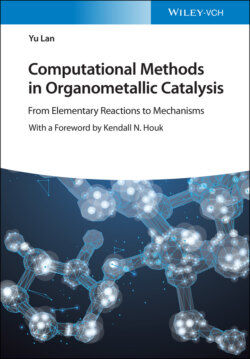Читать книгу Computational Methods in Organometallic Catalysis - Yu Lan - Страница 38
2.5.3 How to Choose a Basis Set
ОглавлениеGenerally, the time taken for DFT calculations is mostly used in the calculation of double‐election integral, which is positively correlated with N4, in which N is the total Gaussian‐type functions for a specific molecule. Therefore, the calculation of time taken for a specific molecule is dependent on the selectivity of basis set for all atoms in this molecule. In fact, the selection of the basis set is also arbitrary, which even could be based on experience and preferences. Fortunately, the accuracy of most DFT methods is not too dependent on the size of selected basis set, while most of large enough basis sets can yield a same result in DFT calculations. Additionally, when the number of base functions for using a basis set is the same, the time spent can be saved by using a basis set with less Gaussian‐type function under the same precision. Therefore, segmented contraction basis sets, such as Pople's basis sets and def2 series of basis sets, are better choice in DFT calculations.
For DFT calculations, regular polarization functions (d,p) are necessary, which can improve the accuracy to a great extent. However, the larger angular momentum functions are unnecessary. A triple‐zeta basis set is usually slightly better than a double‐zeta one. As an example, the basis set of 6‐311G(d,p) for DFT calculations is better than that of 6‐31G(d,p); however, the basis set of 6‐311(3df,2pd) has not shown improvement over that of 6‐311G(d,p). Following this idea, 6‐31G(d) is the smallest acceptable basis set in modern computational organometallic chemistry. The basis set of 6‐311G(d,p) is a better choice for both accuracy and efficiency. When def2 series of basis set is used, def2‐SVP is acceptable, while def2‐TZVP is a better one. In an anionic molecule, defuse function is necessary; therefore, 6‐31+G(d) is the acceptable basis set, while 6‐311++G(d,p) would provide a good accuracy.
For the DFT calculation onto transition metals, employing a pseudo potential basis set is strongly recommended for the consideration of both accuracy and efficiency. In this area, LANL2DZ is the smallest basis set for transition metals, which provides only acceptable accuracy for some geometry optimization. The larger ones, such as LANL2TZ, LANL08, LANL08(d), and LANL08(f), are recommended for 4–6th periodic elements involving transition metals.
Notably, because the accuracy is not obviously dependent on the basis set in geometry optimizations and harmonic vibrational frequency calculations, while the time consumption is large, a smaller basis set usually can be chosen, such as 6‐31G(d), 6‐31+G(d), def2‐SVP, or LANL2DZ. By contrast, larger basis sets are often more suitable in the single‐point calculations with high accuracy, such as 6‐311G(d,p), 6‐311+G(d,p), def2‐TZVP, LANL08 series. Additionally, for some highly parameterized functionals, a basis set consistent with that used in parameterizations is recommended in both geometry optimization and single‐point energy calculation. As an example, a basis set of 6‐311+G(d,p) is recommended for the DFT calculation with M06‐2X functional by that reason.
